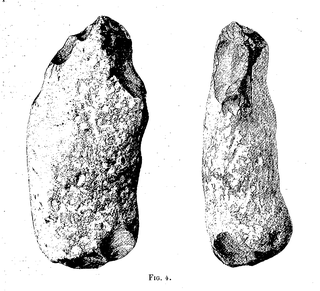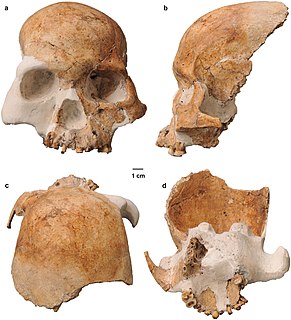 W
WA number of varieties of Homo are grouped into the broad category of archaic humans in the period that precedes and contemporary to the emergence of the earliest early modern humans around 300 ka. Omo-Kibish I from southern Ethiopia and the remains from Jebel Irhoud in Morocco and Florisbad in South Africa are the earliest remains of Homo sapiens. The term typically includes Homo neanderthalensis (430+–25 ka), Denisovans, Homo rhodesiensis (300–125 ka), Homo heidelbergensis (600–200 ka), Homo naledi, Homo ergaster, and Homo antecessor.
 W
WEarly European modern humans (EEMH) or Cro-Magnons were the first early modern humans to settle in Europe, continuously occupying the continent since possibly as early as 48,000 years ago, with intermittent presence since at earliest 210,000 years ago. They interacted and interbred with the indigenous Neanderthals, which went extinct 40 to 35 thousand years ago; and from 37,000 years ago onwards, all EEMH descended from a single founder population which contributes ancestry to present-day Europeans. EEMH produced Palaeolithic cultures, the first major one being the Aurignacian, which was succeeded by the Gravettian by 30,000 years ago. The Gravettian split into the Epi-Gravettian in the east and Solutrean in the west, due to major climate degradation during the Last Glacial Maximum (LGM), peaking 21,000 years ago. As Europe warmed, the Solutrean evolved into the Magdalenian by 20,000 years ago, and these peoples recolonised Europe. The Magdalenian and Epi-Gravettian gave way to Mesolithic cultures as big game animals were dying out and the Last Glacial Period drew to a close.
 W
WAn eolith is a chipped flint nodule. Eoliths were once thought to have been artifacts, the earliest stone tools, but are now believed to be geofacts.
 W
WThe Evolutionary Studies Institute (ESI) is a paleontological, paleoanthropological and archeological research institute operated through the Faculty of Science of the University of the Witwatersrand, Johannesburg, South Africa. Previously known as the Bernard Price Institute for Palaeontological Research (BPI) it was renamed the Evolutionary Studies Institute in 2013 to better showcase the scope of its research.
 W
WThe theory of female cosmetic coalitions (FCC) represents a (controversial) attempt - proposed by evolutionary anthropologists Chris Knight and Camilla Power together with archaeologist Ian Watts - to explain the evolutionary emergence of art, ritual and symbolic culture in Homo sapiens.
 W
WPředmostí (Skalka), situated in the north western part of Přerov, Moravia near the city of Přerov, is an important Late Pleistocene hill site of Central Europe.
 W
WPrognathism is a positional relationship of the mandible or maxilla to the skeletal base where either of the jaws protrudes beyond a predetermined imaginary line in the coronal plane of the skull. In general dentistry, oral and maxillofacial surgery, and orthodontics, this is assessed clinically or radiographically (cephalometrics). The word prognathism derives from Greek πρό and γνάθος. One or more types of prognathism can result in the common condition of malocclusion, in which an individual's top teeth and lower teeth do not align properly.
 W
WThe Red Deer Cave people are a prehistoric archaic human population. Fossils dated to the Bølling-Allerød warming, between about 14,500 to c. 11,500 years ago, were found in Red Deer Cave and Longlin Cave, Yunnan Province, in Southwest China.
 W
WThrowing is the launching of a ballistic projectile by hand. This action is only possible for animals with the ability to grasp objects with their hands.